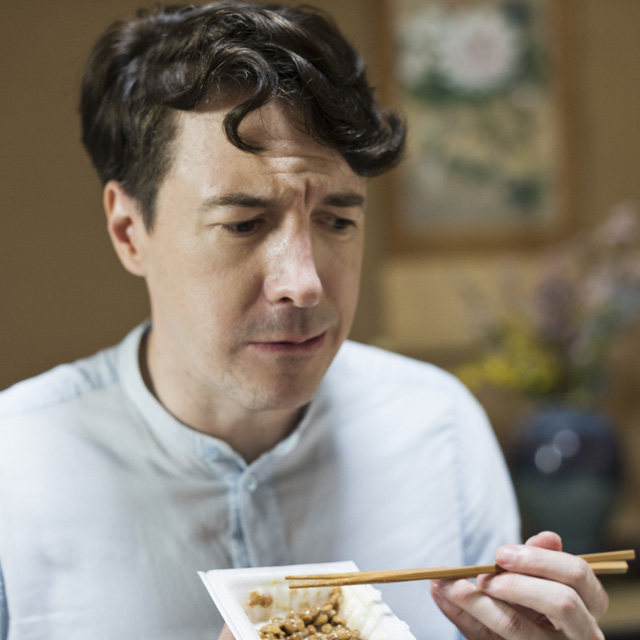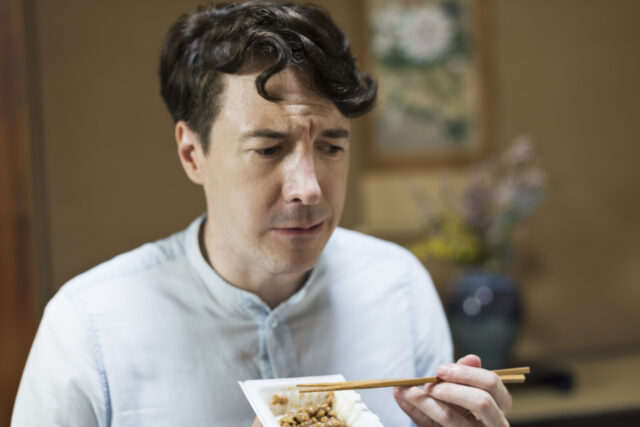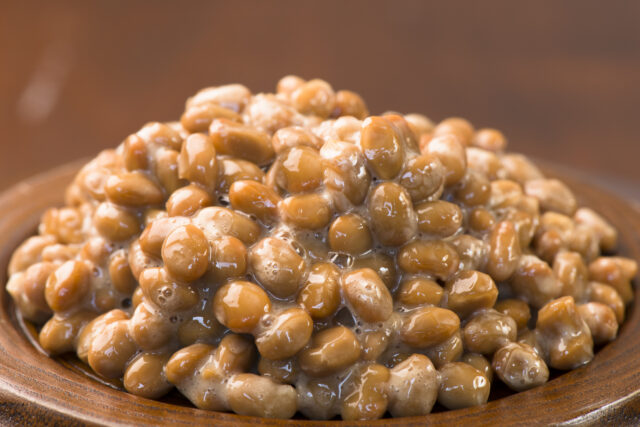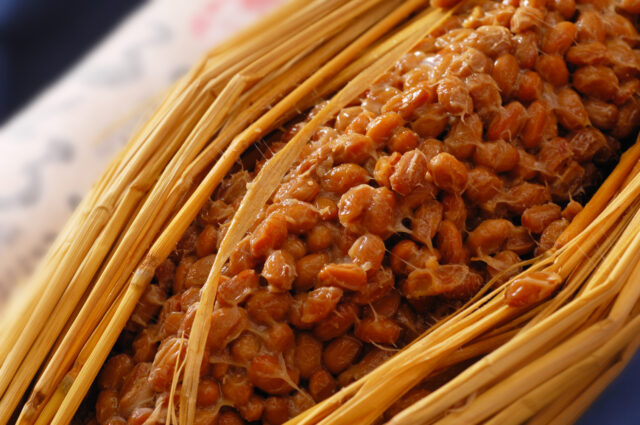
A Story About the Time Haruki Murakami Overcame His Fear of Natto
It’s a familiar story for many of us. You’re having a casual, friendly conversation with some Japanese people who you’ve just befriended, and the topic turns to your affinity with Japanese cuisine and your amazing handling of chopsticks.
Sooner or later you’re going to get that question (maybe with a little cheeky smirk on their face);
“Do you like natto?”
This natto newbie is struggling to find the right words before answering that age-old question.
It may as well be the million dollar question that may determine how much of a Japan aficionado you really are- yes, we know how much you love sushi, tempura and ramen, but can you REALLY call yourself a true connoisseur of Japanese cuisine until you can chew and swallow our gooey fermented bean dish with a smile?
This guy is positive he’s going to seal that multi-billion yen deal today, now that he’s starting his day with this all powerful bowl of rice and natto.
Now, those of you who aren’t exactly fanatical about natto (or prefer to run for the hills at the mere mention of it) may simply shrug and say you don’t get what’s so great about a dollop of sticky soy beans anyway. You don’t feel like you’re missing out on much….but really, isn’t there a small part of you somewhere deep down in your heart, that has secretly been yearning for the ability to like natto, all this time?
If so, then you’re not alone. One of the greatest novelists of our times, Haruki Murakami, couldn’t eat natto until he was 35. As a Kansai native who had never touched or seen natto until he moved to Tokyo as a college student, he was entranced yet mortified by this exotic breakfast staple that the Tokyoites seemed to love so much, and developed what could be described as a minor obsession in an applaudable attempt to add that natto notch on his belt.
In 1985, Murakami published an essay in the women’s lifestyle magazine Fujin Gahou titled “Thoughts on Breakfast, Regarding Natto” (納豆にまつわる朝食あれこれ). In it, he describes his first encounter with natto, and the years of continued advancements and rejection, and the final Eureka moment when he finally became able to not only devour but love the stuff.
A Kansai native born and raised in Kyoto, Murakami had never come across natto because it simply wasn’t eaten in his household. According to him, breakfast culture in Japan greatly differs between the east and west, which I will go into later. Murakami moved to Tokyo when he was 18 years old, and he became very curious to try this natto that he had only heard about until then. The initial encounter, at a local diner where he hesitantly ordered a side of natto with his meal, was not a pleasant one. He found the taste to be “fouly overpowering and bewildering”, which instantly made him decide that this was not for him.
Different strokes for different folks. Personally I’d be happy to eat this
Young Murakami could have simply walked away from natto and never looked back – but he didn’t. His determination to train himself into liking natto one day is truly remarkable. From that day, over the next 17 years, he made countless attempts at natto in various different ways. Unfortunately his tireless experimentations did not go well and he ended up making himself feel physically ill at the mere sight of the sticky matter.
What is it about natto exactly? Is it the smell? The texture?
This is how Murakami describes the moment when the Natto Gods finally rewarded him with the power to love natto which he had been longing for for so many years
“Early this year, while staying at an onsen ryokan in Hakone over the three days of the new year holiday, natto was served at my breakfast table. I decided to just eat the thing to avoid any hassles. That was when the incredible happened. The natto was actually delicious. It was completely beyond my expectations. Since then I have been unable to let a day go by without eating it.”
That’s it. That’s Haruki Murakami’s “a-ha” natto moment.
No shocking, dramatic Hollywood style turnaround, no earth shattering recipe created by a legendary chef, just a solitary revolution on the palate during a quiet winter’s morning, deep in the lush mountains of Japan. And somehow that makes it feel like a quintessential Murakami story.
Sometimes all it takes is enough time, creativity, or a giant leap of faith for your body and mind to appreciate the joys of something new or different.
The novelist goes on to ponder;
“It’s shocking – what a little momentum can do to you. Just like an old song by Dinah Washington, What A Difference A Day Makes, it took just one day to completely turn around a situation that 17 years of continuous dedication didn’t succeed in changing.”
Small tidbit by Murakami about breakfast
According to Murakami, the quintessential Japanese breakfast table is mostly reserved for those from the East Side
According to the rest of this 4 page essay, breakfast in western Japan, known as the Kansai region, usually fixing a bowl of ochazuke (rice soup) topped with last night’s leftovers. He found that people in Tokyo, on the other hand, seemed “fixated on preparing everything from scratch” – freshly steamed rice, miso soup made from stock of freshly grated bonito flakes with tofu bought from the local tofu shop in the early hours of the day, along with a small container of natto, were the basic staples of a Tokyo breakfast.
If you find yourself at the age of 85 looking back at your life, and realising with painful regret that you never tried bungee jumping or natto…at least one of those things can easily be ticked off your bucket list.
So there you have it, all ye who fear the natto…
Next time you feel bold and ready, why not put on a Dinah Washington record (or click on a YouTube playlist) and try your hand at one of Jay’s Hacco-licious natto recipes and see if that veil will be finally removed from your eyes!






